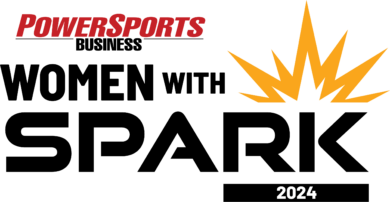Mar. 9, 2009 – Two powerful messages to chew on
It usually takes about a second. Maybe two. Then the nerves kick in, the legs become concrete and the stomach starts sending urgent messages in the way of loud, gurgly protests.
It happens every time I walk out onto a pier overlooking a scenic ocean bay and then for some idiotic reason, peer down into the green depths below.
Never could handle heights. Never could stand roller coasters, and yet here we are on an economic one.
Of all that I have read, heard or consumed via the mainstream media or elsewhere on this sore subject I want to pass along only two incredibly powerful thoughts to chew on. Both come via Paul Leinberger, a brand and marketing strategy expert who has spoken at a number of industry functions.
Leinberger spoke most recently at the Motorcycle Industry Council’s member meeting in Indianapolis and imparted a number of thought-provoking ideas on the current state of affairs. These two, however, were the ones that really stuck out:
You can easily imagine how the latter influences the former.
It’s such a simple thought that it reminds me of a homework assignment my son, a first-grader, brought home last week. It was called the “math machine.” You took a number, any number, and “placed” it into the machine that either added or subtracted it and then it came out as a different number. The number did not, ever, stay the same.
Simple, yet infinitely more difficult to do in the challenging business world? It must be because there is so little today that goes into the “industry machine”?and comes out truly different. Something you could point to and say, “Wow, that’s different.”
Not to say creating a different approach in the marketplace is impossible. Take Yamaha, for example. The OEM is giving dealers access to half of Yamaha’s normal PWC co-op dollars without having to spend any of their own dollars. (See the complete story on pg. 36).
Wow, that’s different.
Or take Neosho Powersports in Neosho, Mo. The multibrand metric dealership sent out an e-mail to its customers alerting them of staffing changes, saying “we do not want you to be surprised when you come into the store.” It goes on to say, “It does not matter who you work with here, the entire staff is committed to you, the boss, the customer.”
Wow, that’s different.
What also needs to be different is the handling of more expensive aftermarket parts and accessories. That belief comes after several days of walking the recently held Dealer Expo in Indianapolis. It is not a scientifically sound judgment, as even the most astute trade show visitor cannot stop at every booth and measure marketing tactics. And I certainly did not come close to that.
But here’s the issue: How do you get more really enticing and profit-producing product, let’s use three-figure ATV and UTV accessories as an example, into a dealership when dealer cash flow is such a problem?
The actual exercise of trying to do this makes a heck of a lot of sense. Consumer spending on new ATVs, for the most part, is down. In fact, pretty severely in many parts of the country. And some OEMs are expecting further difficulties in this area and have cutback on 2009 production as a result. The message: A significant rebound that will rid of us existing inventory not to mention new product doesn’t appear likely.
Thus, achieving profitability through other means has to be carefully examined. That means looking harder at preowned inventory, service department profitability and parts and accessories. The latter figures to be especially key, as we know consumers are apt to enhance what they have when they don’t have the discretionary income to buy new.
My “wow, that’s different” suggestion: Pay a dealer to take a low profit-margin yielding ATV unit off the showroom floor and replace it with a UTV that has a storage element in its bed. Or an ATV that has a front mount kit on it with a number of different accessories — mowers, dump buckets — lying beside it. Include point-of-purchase material that is not only eye-catching but feature-rich.
Hold on, did I just write “pay” a dealer to take in something they’re going to profit on? Absolutely. My suggestion: Give them the equivalent of two months of flooring on that one ATV unit they’re taking off that showroom — that would total around $50 — as well as all the point-of-purchase material and the initial part that will act as the showroom display.
Lots of aftermarket companies would balk at that suggestion. After all, they’re already providing terrific profit margins to dealers and it’s not like the economic downturn that has hit dealers so hard has somehow not impacted their business. But these are not normal times. No matter how terrific and groundbreaking a product you manufacture is, if a dealer doesn’t have the cash to put it in their inventory, it’s not going to be displayed. It will remain a static item among many, many more in a phone book-sized catalog.
This is a rare opportunity for the aftermarket manufacturer to capture some of the showroom floor if they can think outside the box, if they can interact differently with their customer.
Try it. Even if at first glance it makes your knees shake and your stomach quake. psb
Neil Pascale is editor-in-chief of Powersports Business. He can be reached at npascale@affinitygroup.com.




